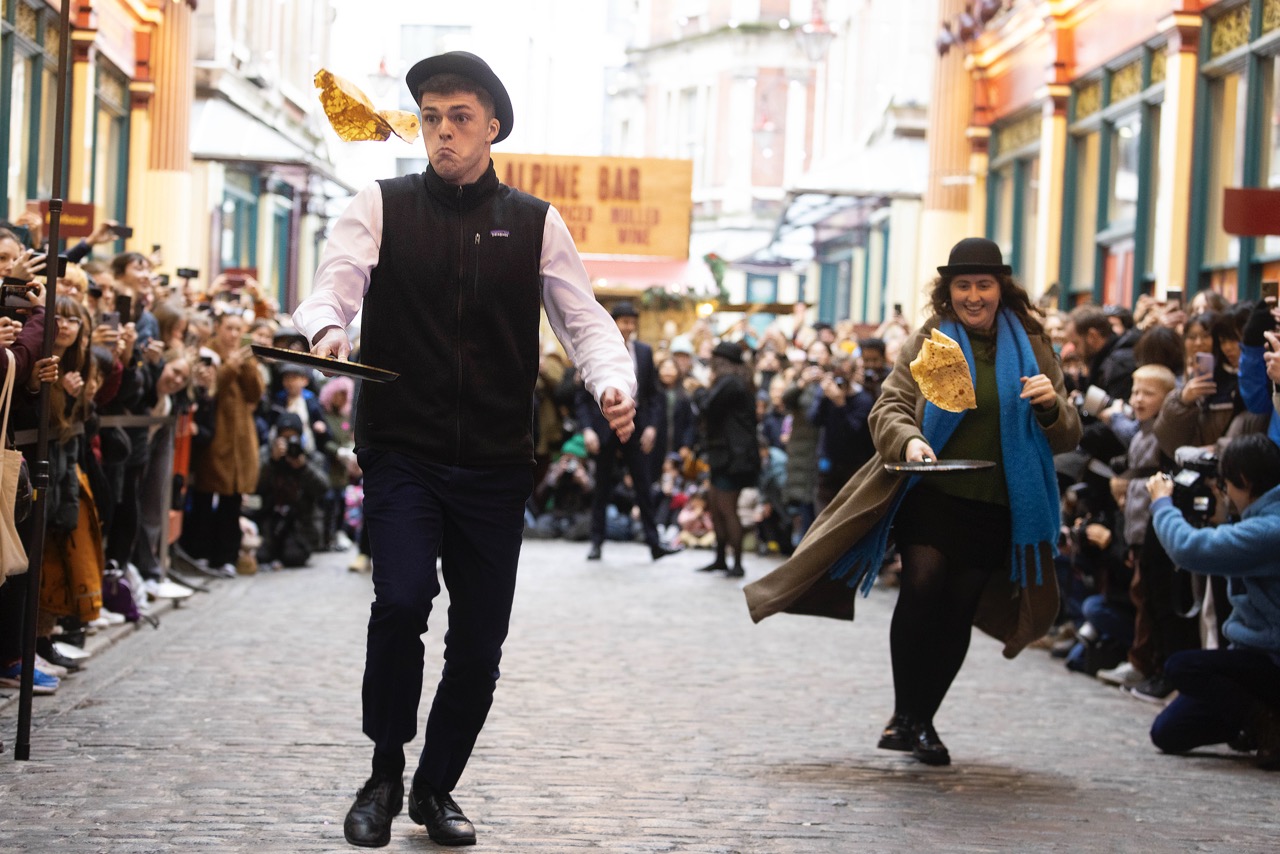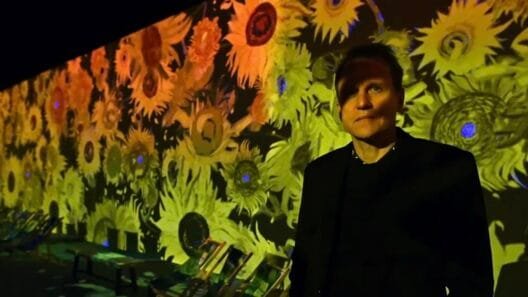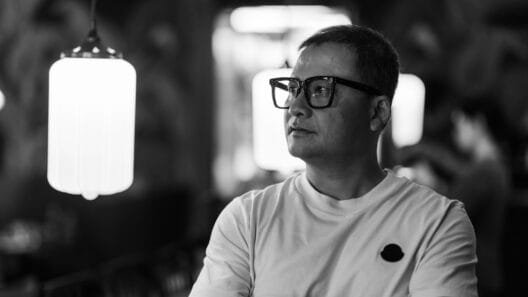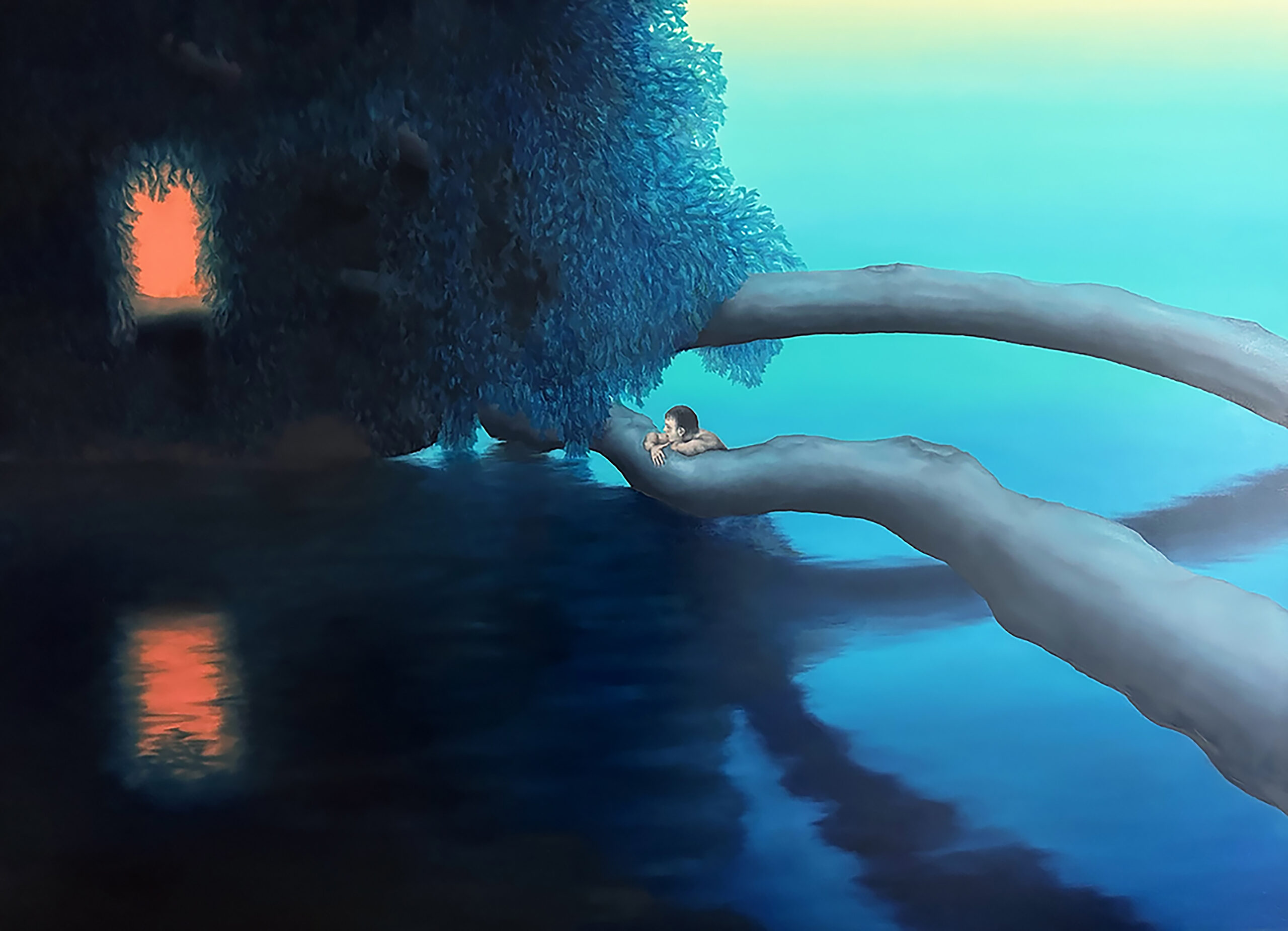In this interview for Made in Shoreditch, Geppy Pisanelli takes us on a journey through the philosophical and visual foundations of his work. Rooted in Italian pictorial traditions yet deeply engaged with contemporary themes, his art explores the interplay of light and shadow, tradition and innovation, and the personal and universal. Through thoughtful compositions and layered metaphors, Geppy invites viewers to engage in contemplation, uncovering deeper meanings over time. Here, he discusses his creative process, cultural influences, and the role of art in an ever-evolving world.
Your works invite contemplation and often uncover deeper layers of meaning over time. How do you balance creating pieces that are accessible yet rich in metaphor and complexity?
Your question touches upon a critical aspect of my artistic approach. In my view, art forms like painting, sculpture, literature, theater, and music are indispensable tools for communication that enhance both personal and communal spiritual growth. Painting is my medium of expression.
In visual arts, I find the notion of “art for art’s sake” somewhat vacuous. Art that focuses solely on aesthetic and formal qualities without delving into deeper content tends to lack depth. Conversely, art that neglects aesthetic appeal and focuses only on content can feel unengaging and cold. Great art, to me, is about the synthesis of ethical and aesthetic values; if its message is resonant universally, then the deeper and more impactful the art becomes. This philosophy guides how I create my pieces, striving to balance esthetic quality with metaphorical richness and complexity, ensuring they invite the viewer to a contemplation, and gradually reveal deeper layers of meaning over time.
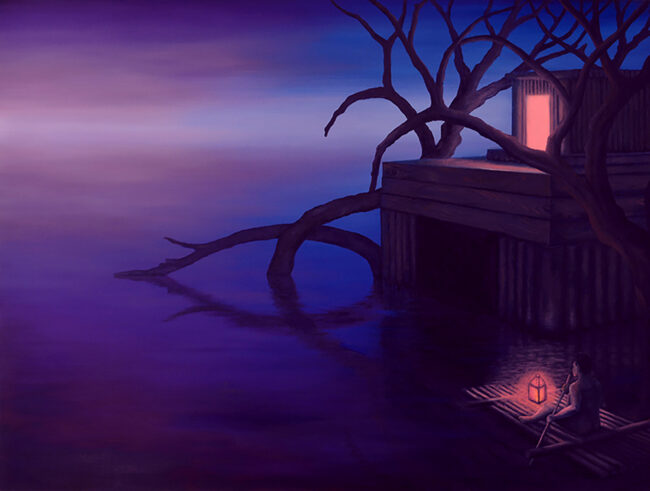
As an artist rooted in Italian Pictorial traditions, how do you navigate blending classical influences with modern, experimental approaches?
Thank you for this question as it allows me to clarify an important point for me. The fact that I emphasized being aware of my Italian Cultural Identity, which, in my opinion, is more deeply rooted in painting, than in literature does not mean that I intend to blend my classical influences with a modern experimental approach.
What I want to emphasize is that Italian Cultural Identity forms the foundation for any Italian artist who seeks to engage in contemporary art discourse. Of course, this discourse is valid also for other cultures. Without acknowledging one’s roots, it is impossible to innovate or create new art. Every novelty has its roots in the past, not through mere sterile quotation or attempts to merge past with present. Instead, I mean that one should be aware of one’s roots and build from there, striving to develop one’s own language and unique pictorial logic. Even as the most innovative of artists, you must stay on the track of your tradition.
I want to provide some examples to clarify this concept further, and I will give you an example of another culture to underline that this is a universal concept. For instance, a Japanese artist has distinct characteristics compared to a European artist, even though we live in an interconnected world. Starting with the artists from the Ukiyo-e period in Japan, who created beautiful woodblock prints. Well-known artists like Hokusai, Hiroshige, and Kunisada crafted works that are celebrated globally. If you notice, among the many peculiarities in their prints, one aspect that has always attracted my attention is that these prints, despite their beautiful color combinations, do not include shadows. In Europe, in contrast, since the Renaissance, the use of shadows in the depiction of faces and bodies has been a constant, becoming especially dominant in the 17th century with Caravaggio.
Today, if you consider some of the most famous Japanese artists, such as Murakami or Yoshitaka Amano, you will see in their work, that they continue this tradition of omitting shadows, even though they are considered avant-garde artists with their own unique styles, own pictorial language and international appeal. Therefore, it is challenging to find a Japanese artist who comes from this tradition and works with the same intensity of chiaroscuro as European artists. This is not because they lack the ability, but rather because the absence of shadow is an integral part of their visual culture.
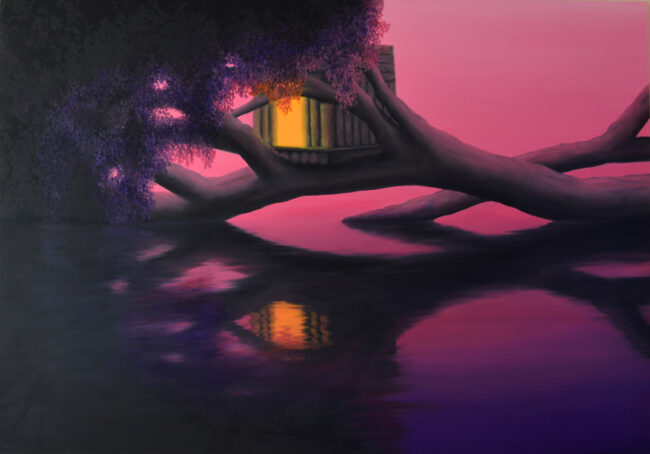
To be even clearer, could you imagine an artist like Lucian Freud, returning to England since your magazine is published there, being born and making his art in Japan?
In one of the pieces displayed at the exhibition entitled: “Il naufragar m’è dolce in questo mare,” which I consider an interlude to the theme of the exhibition, you’ll notice a man on a raft gazing towards the horizon. The raft carries three paintings, each illustrating elements from renowned artworks: ‘David with the Head of Goliath’ by Caravaggio, ‘The Last Judgment’ by Michelangelo, and ‘Hector and Andromache’ by de Chirico. In this painting, I, the artist, represented as the man who metaphorically brings along three influential painters (Caravaggio, de Chirico, and Michelangelo), who symbolize the essence of Italian cultural heritage and identity, navigate towards the future of art. I selected these artists because, for me, they form the pillars of our cultural identity. Through this painting, it visually represents what I mentioned before with my aim of conveying that Italian cultural identity, which is crucial for any Italian artist wishing to participate in contemporary art discourse. Recognizing one’s heritage is essential for innovation and the creation of new art.
Given the tumultuous global challenges—like climate change, war, and migration—that inform this series, how do you view the role of art in addressing such crises? Do you see yourself as a messenger, a reflector, or something else entirely?
Thanks for this question because it allows me to better explain my point of view on this matter. I want to clarify that in my work, I do not intentionally guide the viewer through these themes, but rather, I leave space open for the contrasting elements of human thought.
Of course, I was aware that placing a raft in some of these paintings could evoke stories of hope or abandonment, whether reflecting the inner spirit or on a collective scale, but it was not a direct reference to migration. I am pleased that all these interpretations have emerged because it demonstrates that my paintings can be interpreted on multiple levels of meaning.
Art, in my view, holds a unique position when it comes to addressing global challenges. It does not directly solve these problems but provides a space for reflection, questioning, and sometimes healing. Through art, we can explore the complexity of these issues in a way that is personal and universal, evoking emotions and thoughts that might not be stimulated in other forms of dialogue.
In terms of my role, I see myself neither as a messenger nor merely a reflector but perhaps as a channel. My aim is to create art that opens up spaces for personal interpretation and connection, where the viewer can find their own meanings and resonances. If my work encourages viewers to contemplate deeper global issues, then it is serving a profound purpose. Art’s power lies in its ability to open minds and hearts. The more open-minded people are, the more their analytical skills enable them to understand reality and make significant decisions. This is the moment when ethics coincide with aesthetics, and if my paintings can contribute to this in any way, my role as artist is accomplished.
Your exhibition title, Hidden Lights, presents a fascinating contradiction. What inspired this oxymoron, and how do you see it resonating with the themes of the works?
Addressing your comment about the title “Hidden Lights,” the choice of this oxymoron was deeply intentional and reflective of the core themes within the exhibition. This title encapsulates the juxtaposition of visibility and obscurity, elements that are central to the artworks displayed. Plus, I have to say that in general I find myself continually drawn to the use of oxymorons because they encapsulate the essence of contradiction within a single phrase. The juxtaposition of contradictory elements within oxymorons mirrors the thematic exploration of light and darkness, visibility and obscurity, which are central to my work.
The concept of “Hidden Lights” was inspired by the idea that illumination, typically associated with clarity and revelation, can also be subtle, even concealed within the broader context of darkness or shadows. This duality mirrors the visual explorations in my paintings, where light does not just reveal but also hides creating a dynamic interplay that invites viewers to look deeper and discover the nuanced layers beneath the surface.
In the artworks, this theme resonates through the depiction of physical light interacting with dark landscapes and man-made objects, as well as metaphorically through the exploration of human consciousness and hidden emotional states.
The title invites viewers to consider how light, whether emotional, physical, or intellectual, can be present yet not immediately apparent, urging a deeper engagement and contemplation to uncover the full breadth of its influence.
Thus, “Hidden Lights” serves as both a literal and figurative exploration of how the seen and unseen shape our perception and understanding, reflecting the complexities of the human experience and the ever-present interplay between what is immediately observable and what lies beneath the surface.
In this series, you juxtapose natural and artificial elements to evoke alienation. Can you share how this contrast reflects broader societal or environmental concerns?
In this series, the juxtaposition of natural and artificial elements is designed to evoke a sense of visual unexpectedness and to reflect my intent to explore an inner condition. The use of natural elements is not merely to explore the natural world but to construct a visual stage that represents an inner human state.
In my work, I carefully organize natural and artificial elements to create what I define as “theatrical landscapes” that transform the environment into a narrative space. These scenes are meticulously constructed, much like a playwright or stage director would design a theatrical set, to draw viewers into a crafted reality where each element is placed to deepen the narrative and enhance viewer involvement.
For example, the illuminated tree house positioned on a fallen tree was specifically chosen to emphasize this intent. By placing a man-made structure within a natural setting in this manner, I anticipated it could provoke various reactions; from an aesthetic standpoint regarding composition, to strong contrasts and colors, or to interpretations of it being seen as a solitary inner refuge or as a symbol of civilization.
However, the unexpected interpretation of it as or as an emblem of human resilience and adaptability, or as a place to begin anew after a cataclysm was a surprise for me. It adds an additional layer to the artwork. It suggests that amidst destruction or upheaval, there is room for renewal and hope.
This aligns with broader societal and environmental concerns, particularly the resilience required to address and adapt to challenges like climate change, natural disasters, and social upheaval. My work aims to remind viewers of the potential of art, in this case painting, serving as a powerful medium that not only reaches into the depths of individual experience but also addresses broader societal themes.
David H. Lawrence’s words about resilience amidst tragedy deeply influenced this series. How did his philosophy shape your creative process or your approach to storytelling in these works?
D.H. Lawrence’s investigations into human tenacity and its incidental overlap with my artwork occurred by chance. His philosophy did not shape my creative project. Specifically, my artistic process in painting has never been directly influenced by any literary works.
The language and rationale of painting, as I perceive it, exists independently from the literary realm. However, I encountered a quote by Lawrence that profoundly struck me: “Ours is essentially a tragic age, so we refuse to take it tragically. The cataclysm has happened, we are among the ruins, we start to build up new little habitats, to have new little hopes.” This reflection on rebuilding from devastation aligned with the themes in my paintings, where I focused on depicting minimal survival units such as tents, rafts, and shelters. These elements symbolize the foundational shelters that suggest a modest starting point for a renewed existence. Thus, while my paintings were not initially inspired by Lawrence’s writings, they inadvertently embody the same concept of regeneration and resilience he articulated, serving as visual representations of beginning anew in the aftermath of moral and, in some part of the world, physical destruction. In summary, my artwork unintentionally visually echoes Lawrence’s ideas, albeit in retrospect.
You explore the interplay of light and darkness as both a visual and symbolic theme. What specific techniques or color palettes did you use to convey this duality in the paintings?
The techniques and the color palettes that I used in these paintings are a part of my painting process, which begins with addressing the composition and subject matter. It starts with a preliminary sketch that outlines the basic idea on paper. As the painting develops, I gradually add more elements to achieve a balanced composition. Once the initial framework is in place, I work on a larger, more detailed drawing. This stage involves a careful analysis of how light and shadow play within the piece, making adjustments by adding or removing details to refine the visual impact. This detailed sketch is then transferred to the canvas, where I finalize the choice and layout of colors.
The painting phase begins, allowing for further modifications in composition and color adjustments to enhance depth and contrast between the light and dark areas. Regarding the palette of color that I used to convey this dual effect as you can see is a palette of very limited colors. Usually, I choose a dominant color that I feel is appropriate for the subject and composition, then this color is shaded from light to dark to achieve a color gradient that gives the painting a movement of color. To this dominant color, I add a complementary color that contrasts with the previous one, so in addition to the chiaroscuro contrast that generates shadows, there is a contrast within the complementary colors which enhance each other.
As you can see the crafting of light, darkness, and colors in my paintings is a meticulous and layered process, culminating in the final artwork. However, the process is fluid and can extend beyond what seems like completion. Indeed, I often revisit and revise paintings months or even years later, continuing to evolve their visual stories.



